Diversity and inclusion is one of the most important areas for us as we grow our company.
We’d love to help others embrace it as well.
In addition to all the benefits we’ve seen — innovation, product quality, unique perspectives, team morale, success — we believe in diversity and inclusion because it is the right thing to do and is the type of future we want to build toward. This article contains a lot more detail on the subject as well as specific strategies and tactics that you can implement today in your workplace.
Thanks for finding this article and for your interest in the topic. Keep reading for all the details, and return to this post whenever you need (we’ll keep it updated as time goes on).
What’s ahead:
-
- What is diversity and inclusion
- The benefits of prioritizing diversity and inclusion
- How to get started: Best practices
- Inclusion strategies for the workplace
- Quick ideas and tactics to try today
- How to measure if your efforts are working
- Resource: Inclusive language guide (what to say / what not to say)
- Resource: Hiring guide for building diverse and inclusive teams
- Resource: Code of Conduct for events
- Learn more: further resources
We regularly cover diversity and inclusion topics on our Open blog. If you’d like to stay in touch with our latest articles, we’d love to have you subscribe.
What is diversity and inclusion?
Diversity refers to the full range of human differences.
Workplace diversity is the understanding, acceptance, and value that is placed on the differences between coworkers. These differences may include but aren’t limited to:
- Race, ethnicity, gender, age, religion, physical ability or attributes
- Education, personality, skill, experience, knowledge
Inclusion is the environment that you create in order to collaborate, support, and respect these differences.
Often times, you may hear diversity and inclusion (abbreviated as “D&I”) used in conjunction with one another. “Diversity and inclusion” is the company-wide mission, strategy, and tactics that support diversity in the workplace.
Still a bit unsure of the definitions? This metaphor sums it up nicely:
Diversity is being invited to the party; inclusion is being asked to dance. – Verna Myers, diversity and inclusion expert
Why diversity and inclusion matter (numbers and anecdotes)
The stats
- Companies with a diverse workforce are 35 percent more likely to outperform those without diversity initiatives. (source)
- White men account for 59 percent of executives. (source)
- 72 percent of tech founders believe in the importance of diversity, but only 12 percent have five or more employees in tech roles who are from underrepresented groups. (source)
- In the United States, there is a linear relationship between racial and ethnic diversity and better financial performance: for every 10 percent increase in racial and ethnic diversity on the senior-executive team, earnings before interest and taxes (EBIT) rise 0.8 percent. (source)
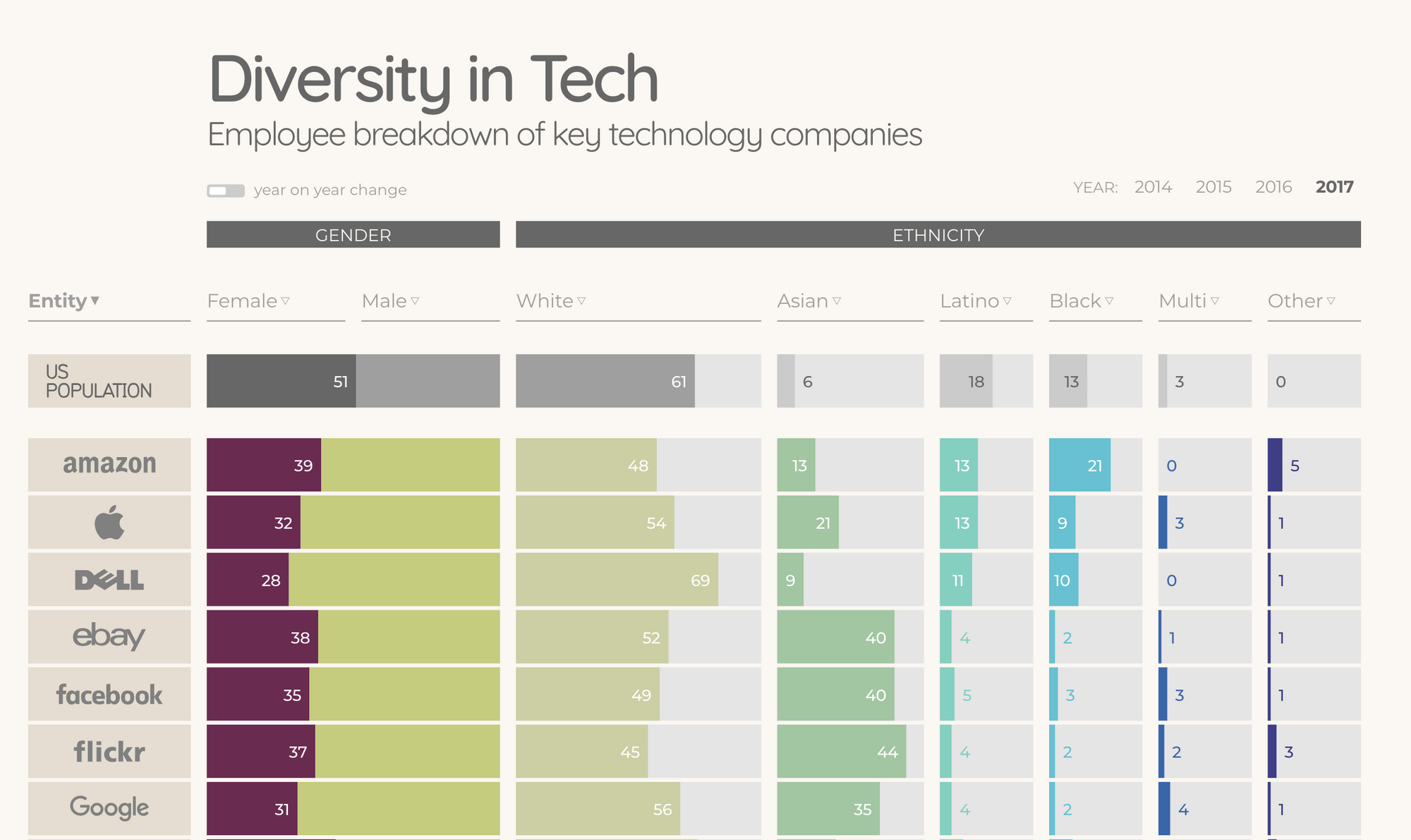
The stories
- When YouTube first rolled out its iOS app for uploading video, 5 to 10 percent of videos were uploaded upside-down. The company’s almost exclusively right-handed developer team didn’t consider the needs of the left-handed.
- Oculus initially caused motion sickness in women because the equipment was developed and tested primarily by men.
- People with mental health or other issues who try to get help from Siri and Alexa – often can’t.
- Apple’s Health app for tracking “key health metrics” initially left off a tracker that about half the world’s population might use on a monthly basis: one for the menstrual cycle.
- Google is more likely to advertise executive-level salaried positions to search engine users if it thinks the user is male.
- The only artificial heart on the market fits 80 percent of men and only 20 percent of women.
- Female drivers are 47 percent more likely to be seriously injured in a car crash because test crash dummies were modeled after the average male in height, weight, and stature.
- Racial biases are baked into the software products that are increasingly being used as predictive tools in criminal sentencing.
The benefits of prioritizing diversity and inclusion in your business
There are real, significant benefits to focusing on diversity and inclusion in your workplace. We’ve seen these benefits first-hand, and we’ve heard countless stories from others. What follows are the main three reasons why we have chosen to prioritize diversity and inclusion at Buffer and why we think it’ll make sense for you to consider, too.
1. Diversity makes teams more innovative
- People with different backgrounds bring unique information and experiences to tasks.
- Interacting with individuals who are different forces group members to prepare better, anticipate alternative viewpoints, and expect that reaching consensus will take effort.
- Diversity encourages the search for novel information and perspectives, leading to better decision making and problem solving.
These innovation factors have also been proved out with data. Decades of research has shown that socially diverse groups (those with a diversity of race, ethnicity, gender and sexual orientation) are more innovative than homogeneous groups.
2. Diversity builds better products
Algorithms and products are not neutral.
Tech CEO Anil Dash wrote about this in an article about the tech industry in particular:
The values of technology creators are deeply ingrained in every button, every link, and every glowing icon that we see. Choices that software developers make about design, technical architecture or business model can have profound impacts on our privacy, security and even civil rights as users. When software encourages us to take photos that are square instead of rectangular, or to put an always-on microphone in our living rooms, or to be reachable by our bosses at any moment, it changes our behaviors, and it changes our lives.
We’ve seen lots of evidence of these biases in the tech we use every day. Products, apps, algorithms, and everything else that’s built by humans is likely to reflect the perspectives of those humans. The more perspectives we can bring to the products we build, then the more valuable those products will be for more people.
3. More and more of the workforce expects an inclusive work environment
The workplaces of tomorrow are moving toward diversity and inclusion. Many are making huge strides today. This shows up in factors like hiring and long-term success.
- A focus on diversity brings in more candidates: In a Glassdoor survey, two-thirds of those polled said that diversity was important to them when evaluating companies and job offers. Deloitte found that 80 percent of employees say that inclusion is an important factor in choosing an employer.
- There is also a direct correlation between greater inclusivity and long term success — notably measurable improvements in office morale and business health.
Bonus: Diversity and inclusivity are key to the future we want to build
At Buffer, we strongly believe that opportunities — jobs, education, funding, support — be equally available for everyone. Right now, they’re not.
- Black and Latinx folks, who collectively represent almost 30% of the U.S. population, still make up only 5% of people in tech.
- On average, women are promoted at a lower rate than men. The biggest gender gap is at the first step up to manager: entry-level women are 18 percent less likely to be promoted than their male peers.
According to USA Today, the pipeline of talent is not the problem in the U.S. Last year, 4.5% of all new recipients of bachelor’s degrees in computer science or computer engineering from prestigious research universities were black, and 6.5% were Hispanic. Black and Latinx students are graduating with CS degrees at twice the rate that tech companies are hiring them.
As we all create the future of work, we have the opportunity to be the change we wish to see.
For even more on this topic, check out our full blog post about the benefits of diversity in the workplace.
The 3 Research-Backed Benefits of Diversity That Guide Our Team Growth
Where to begin: How to get started with diversity and inclusion in your company
Note: Implementing diversity training programs the wrong way can actually have the opposite effect: they can make majority groups feel threatened, have little positive effect and may even decrease representation of the groups that would make an organization more diverse.
When we talk about implementing diversity and inclusion in a workplace, it can be tricky to know where to begin.
There’s so much work to do.
The key thing is to just get started.
A survey of more than 300 HR executives, conducted by Cornell University, found that there are several commonalities among approaches with D&I. Here is a short list of best practices that were mentioned among this group:
- Fair treatment
- Equal access to opportunity
- Teamwork and collaboration
- A focus on innovation and creativity
- Organizational flexibility, responsiveness, and agility
- Conflict resolution processes that are collaborative
- Evidence of leadership’s commitment to diversity (e.g., appointing a Chief Diversity / Equality Officer)
- Representation of diversity at all levels of the organization
- Representation of diversity among internal and external stakeholders
- Diversity education and training
Some of these things may sound tenuous at first (what does “fair treatment” look like in practice?), so we’re happy to share a few specific strategies, tactics, and resources that can help make these best practices seem more clear and achievable. See the next section below for the details.
Simple strategies to follow to begin to see results
We’ve explored many different D&I strategies at Buffer, several of which came out of a period in our company where we had a full role devoted to inclusivity. Having this role helped us be specific about the outcomes we wanted to achieve with inclusivity (you can see the full role description here).
Based on that role, here’s a template that you can begin with in order to shape your own D&I strategy:
Create an environment where those of all ages, races, classes, ethnicities, gender identities or expressions, sexual identities, abilities, sizes, nationalities, cultures, faiths, neurotypes and backgrounds can feel welcome and experience a sense of belonging.
After setting the vision for diversity and inclusion, we then filled in some specific types of strategies and activities we wanted to try. The following ideas are based largely on our past learnings and on the diversity and inclusion roles and research that inspired us from companies like Deloitte, Atlassian, and others.
Invest at the C-level (executives)
- Create a focus and strategy at the CEO/COO/CHRO level
- Work with the CEO and leadership team to create an environment where teammates have the freedom to share their “whole selves” openly
- Assign a top executive the responsibility for leading and/or sponsoring the diversity and inclusion program
Build playbooks on how to act
- Create and share clear behavioral standards. Holding leaders accountable for results (more on measuring results below)
- Craft, edit and/or monitor internal processes like salary formula, performance reviews, benefits, family leave and more with a focus on supporting a diverse team and growing more diverse still
Kick off training programs, small or big
- Train people at all levels on topics like unconscious bias
- Create resources to encourage team-wide education on inclusivity topics and act as an advice giver to any teammates who would like one
Hire with diversity in mind
- Integrate diversity and inclusion strategies in recruitment, performance management, leadership assessment, and training
- Continuously work to develop a diverse pool of candidates through a variety of recruitment experiments. (See our hiring playbook below.)
Build a supportive community
- Create employee networks (e.g, employee resource groups, community outreach groups)
- Support and build relationships with groups and individuals working to advance the presence of underrepresented groups in technology careers and positions
Hold yourselves accountable publicly
- Create an externally visible scorecard to measure progress including metrics for recruiting, promotion rates, compensation levels, turnover, etc
- Share transparently your efforts (successes, failures, challenges, everything!) towards more inclusivity through various forms of content like blog posts, podcasts, videos, etc.
Take stock of where you’re at
- Audit the current state of the company’s diversity and inclusion efforts
- Advocate for more inclusive products and marketing materials wherever possible, by considering elements like accessibility, language, representation and more
Build D&I into the budget
- Contribute to the future of diversity in tech through the development of fellowships, sponsorships, internships and other initiatives
13 diversity and inclusion ideas you can implement today
The strategies mentioned above may take time to fully see results. It’s worth the wait! In the meantime, here are a host of quick wins that can begin to build the foundation and expectation of a diverse workplace.
1. Use inclusive language
This can be as simple as cracking down on use of the colloquial “hey guys” greeting when you address groups of people, not all of whom may be men. Or, you can grab from any of the below list of affirmative terms and adopt them with your team:

We also have a full Guide to Inclusive Language below, which you are welcome to copy, edit, and ship to your team.
2. Expose yourself to counterstereotyping imagery (as simple as a screensaver)
Blindspot co-author Mahzarin Banaji came up with a simple and unique solution to combat some of her own “mindbugs:”
“She created a screensaver for her computer that displays images of a diverse array of humanity. She assumes that these images may do little more than keep her alerted to the actual range of diversity in the world, as opposed to that of the more limited set of humans she encounters in her daily experience. She also favored images that represent counterstereotypes. Short bald men who are senior executives is one of her favorite counterstereotyping images. Another is a drawing from a New Yorker magazine cover, of a construction worker with hard hat on, breast-feeding her baby.”
There’re lots of great options for diverse images on UnSplash.
3. Consider your office furnishings
At the University of Washington, Sapna Cheryan demonstrated that adding more feminine decor to computer science classrooms strengthened women’s associations of female gender with the possibility of computer science careers.
4. Empower mentors for underrepresented groups
This is her theory that successful people in your group who look like you, like teachers and peers, can function as a “social vaccine” that inoculates you from some of the self-doubt or alienation you might otherwise face in such a situation.
This could means that having even a few visible members of underrepresented groups on your team could have a compounding effect, if your organization can encourage and support mentoring relationships.
5. Use social media to amplify new voices
Did you know, in its analytics section, Twitter will tell you the gender split of your followers?
After discovering that he followed a nearly equal ratio of women and men, but retweeted men three times as often as women, the blogger and entrepreneur Anil Dash tried an experiment: For a year he attempted to amplify different kinds of voices than he normally would by retweeting women exclusively.
6. Find members of underrepresented groups that you admire
In a study of racial implicit bias, participants revealed less bias after being shown “black examplars”—pictures of famous and admired people like Martin Luther King Jr., Colin Powell, Michael Jordan and Denzel Washington. This means one easy way to work on unconscious bias could be to simply seek out more admired members of underrepresented groups and focus on those people’s work more often.
7. Use your imagination: Counter-program your brain
At the University of Colorado, researcher Irene Blair discovered that simple imagination exercises were enough to weaken some implicit stereotypes.
She asked a mixed-gender group of college students to “take a few minutes to imagine what a strong woman is like, why she is considered strong, what she is capable of doing, and what kinds of hobbies and activities she enjoys.”
The participants came up with all sort of images, from bosses to athletes. And no matter what their image was, participants who engaged in the mental imagery exercise produced “substantially weaker implicit stereotypes” compared with participants who engaged in neutral mental imagery or no mental energy.
8. Blogging: Explore issues in your industry that affect underrepresented groups
We have two blogs at Buffer: one about business-building and social media marketing and this one about workplace culture and behind-the-scenes stories of Buffer. Having this second blog allows us the opportunity explore a host of new topics, including some of the issues in tech that affect underrepresented groups. Recently, we’ve written about:
- How to bring your authentic self to work, no matter your sexual orientation
- Our approach to diversity at tech conferences and events
- Our gender pay gap
9. Mix up the images you use on your website
We have a host of different places where we show images of people on our website: customer stories, teammates, social media profiles, product avatars and much more. These haven’t always been top of mind for us when it comes to diversity, but we’ve recently taken strides to freshen up these pages with more diverse imagery. You can check out our Journey page or see an example below from our homepage:
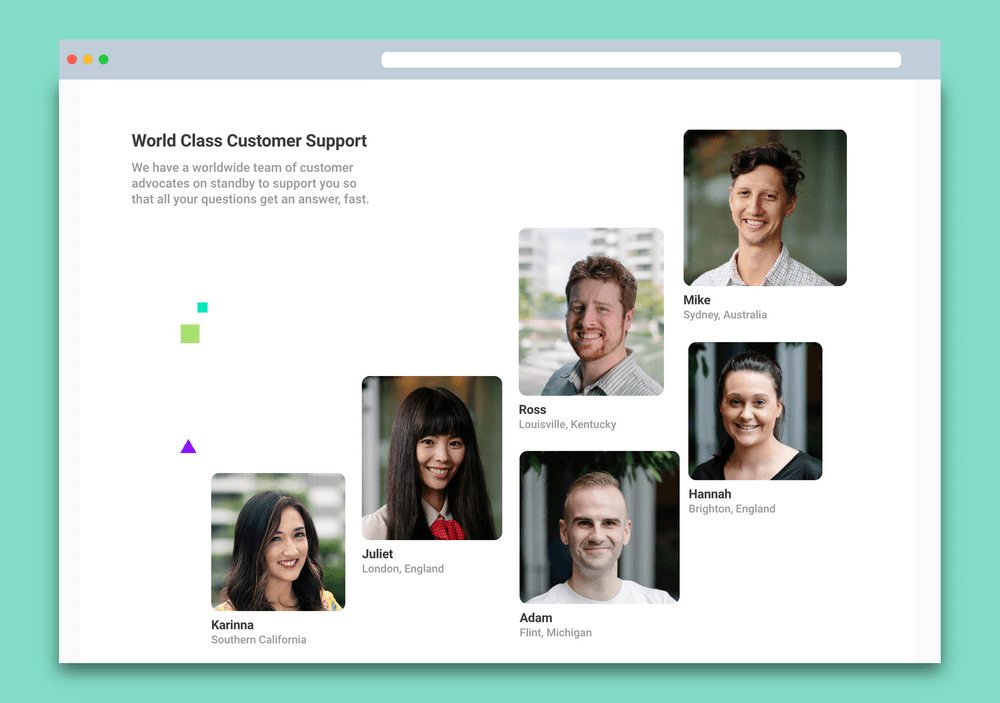
10. Invite guest speakers to offsites or team events
Bringing in smart voices who can help you learn about diversity and inclusion is an easy way to fill knowledge gaps or help the team learn new perspectives. We host events like social media chats and hold internal team meetings where we discuss topics together; at a past team retreat, we spent an afternoon with the awesome folks at Paradigm, who gave us an incredible course in understanding unconscious bias.
11. Sponsor awesome initiatives
We’ve been fortunate to have some room in the budget to put toward projects like #wocintech‘s stock photos project and Lesbians Who Tech’s leadership summits. On a smaller scale, we’ve contributed to non-profits focused on underrepresented groups, giving money when our team reaches certain goals or milestones.
12. Rethink your interview questions
This can be a super quick one to implement: What questions do you ask in interviews? How inclusive are the questions?
Transforming our interview process to reduce bias and level the playing field has made a significant difference in the types of candidates we attract and hire. You can check out our complete hiring playbook further below in this article.
13. Break your filter bubble by exposing yourself to new voices
We’ve written about 12 different ways to add more diversity into your media feeds and online browsing. You can check out the full post for complete details, and here are a couple favorite tips:
- Find and follow new voices on Twitter. Specifically, choose thought leaders and profiles of people who are different than you
- Subscribe to newsletters from a diverse perspectives. Check out the blog post for a list of ideas!Share your open roles in new locations that focus on less-represented audiences
To dive deeper into the research and data behind some of these D&I ideas, we put together this blog post full of information about how to be more inclusive in the workplace:
7 Simple Ways to To Be More Inclusive in Work and Life
How do you know if your D&I efforts are working?
Diversity and inclusion can sometimes feel more art than science.
Still, if your company requires numbers to measure the investment in D&I, we’d love to give you some ideas on what to look at in order to have that ROI conversation. Or if you’re eager to see signs that all your hard work is beginning to pay off, we have stats for that, too.
For starters, you can look at the raw numbers. Quite simply: Are you more diverse today than you were yesterday?
We track these stat on a publicly transparent diversity dashboard. You can track yours in something as straightforward as a spreadsheet or team doc.
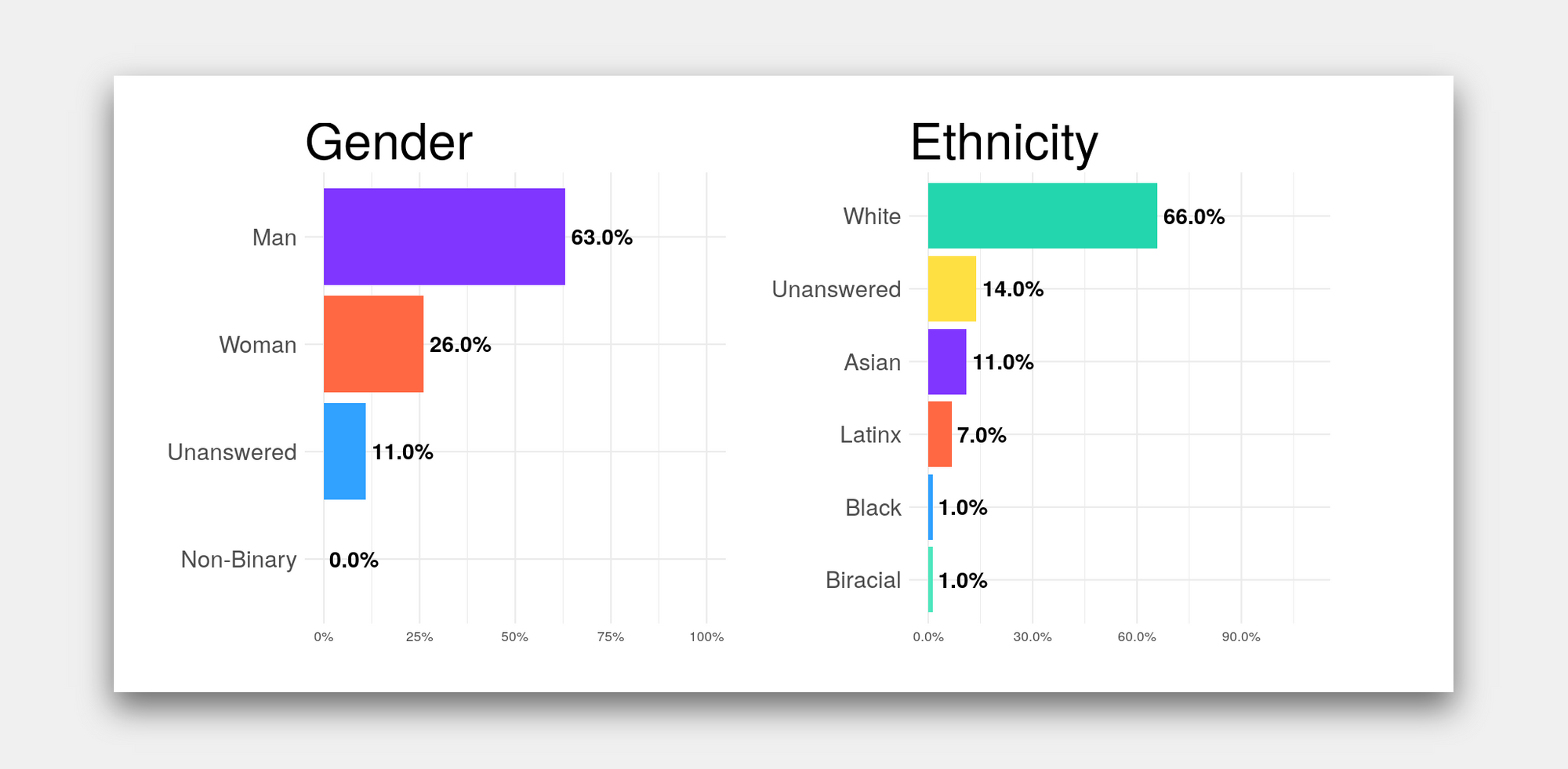
Beyond the direct measure of diversity, here is a short list of some of the other metrics that can inform you about your D&I progress:
- Employee productivity — Are you getting more done as a team? The thinking is that emotional safety and productivity are highly correlated. If your team feels safe and comfortable at work, they’ll get more done.
- Employee morale — How much joy does your team have at work? This can be measured in a number of ways by a handful of different tools (more below).
- Employee turnover — Are people sticking around? Many factors can go into employee turnover and retention, and diversity is definitely one of them.
To measure some of these softer metrics like morale, we rely on team surveys and feedback tools. We’ll send out regular surveys via Google Forms, and we ask weekly questions to all team members via the OfficeVibe Slack app.
If we couldn’t measure the impact of our diversity and inclusion efforts and programs, it would be a hard sell among company executives. –
Huey Wilson, SVP HR & Diversity Board Member, Mattel (via)
To If you’re curious to learn more, you can see a full list of the tools we use on our remote team — including the ones for measuring team happiness.
Resource: Inclusive Language Guide
An Incomplete Guide to Inclusive Language for Startups and Tech
One of our most talked-about topics with diversity and inclusion is quite simply how to talk.
What are the best words and phrases to use?
What are the ones to avoid?
In a well-intentioned workplace, this type of knowledge can be really useful to share explicitly. We put together a complete guide to inclusive language — er, rather an “incomplete” guide since diversity and inclusion is ever-evolving and we’re sure we’ve missed some bits.
Here is a general overview of the principles behind the specific advice in our guide.
- Put people first: Default to person-first constructions that put the person ahead of their characteristics, e.g., instead of “a blind man” or “a female engineer,” use “a man who is blind” or “a woman on our engineering team.” People-first language keeps the individual as the most essential element; there is more to each of us than our descriptors. Mention characteristics like gender, sexual orientation, religion, racial group or ability only when relevant to the discussion.
- Avoid idioms, jargons, and acronyms: Jargon and acronyms can exclude people who may not have specialized knowledge of a particular subject and impede effective communication as a result. Many idioms don’t translate well from country to country, and some are rooted in negative connotations and stereotypes (“hold down the fort,” “call a spade a spade” are examples).
- When speaking about disability, avoid phrases that suggest victimhood, e.g. “afflicted by,” “victim of,” “suffers from,” “confined to a wheelchair”. While you’re at it, steer clear of euphemisms like “challenged,” “differently abled,” or “specially-abled,” too.
- Don’t underplay the impact of mental disabilities. Terms like “bipolar,” “OCD” and “ADD” are descriptors of real psychiatric disabilities that people actually possess. They are not metaphors for everyday behaviors. Also, avoid derogatory terms that stem from the context of mental health, for example, “crazy,” “mad,“ “schizo,” or “psycho.”
- “Guys” is not gender neutral. “The ”universal male” (i.e., using “guys” to mean “people”) assumes that the normal, default human being is male. “Although “he” and “man” are said to be neutral, numerous studies show that these words cause people specifically to think of males.
- If you aren’t sure, ask. Strive to include language that reflects peoples’ choice and style in how they talk about themselves.
Our guide goes on to tell 37 Phrases to know and 18 words to avoid. Also included is the following roundup of alternative ways to phrase some of the most common, less-inclusive terminology that we hear in the workplace most often.
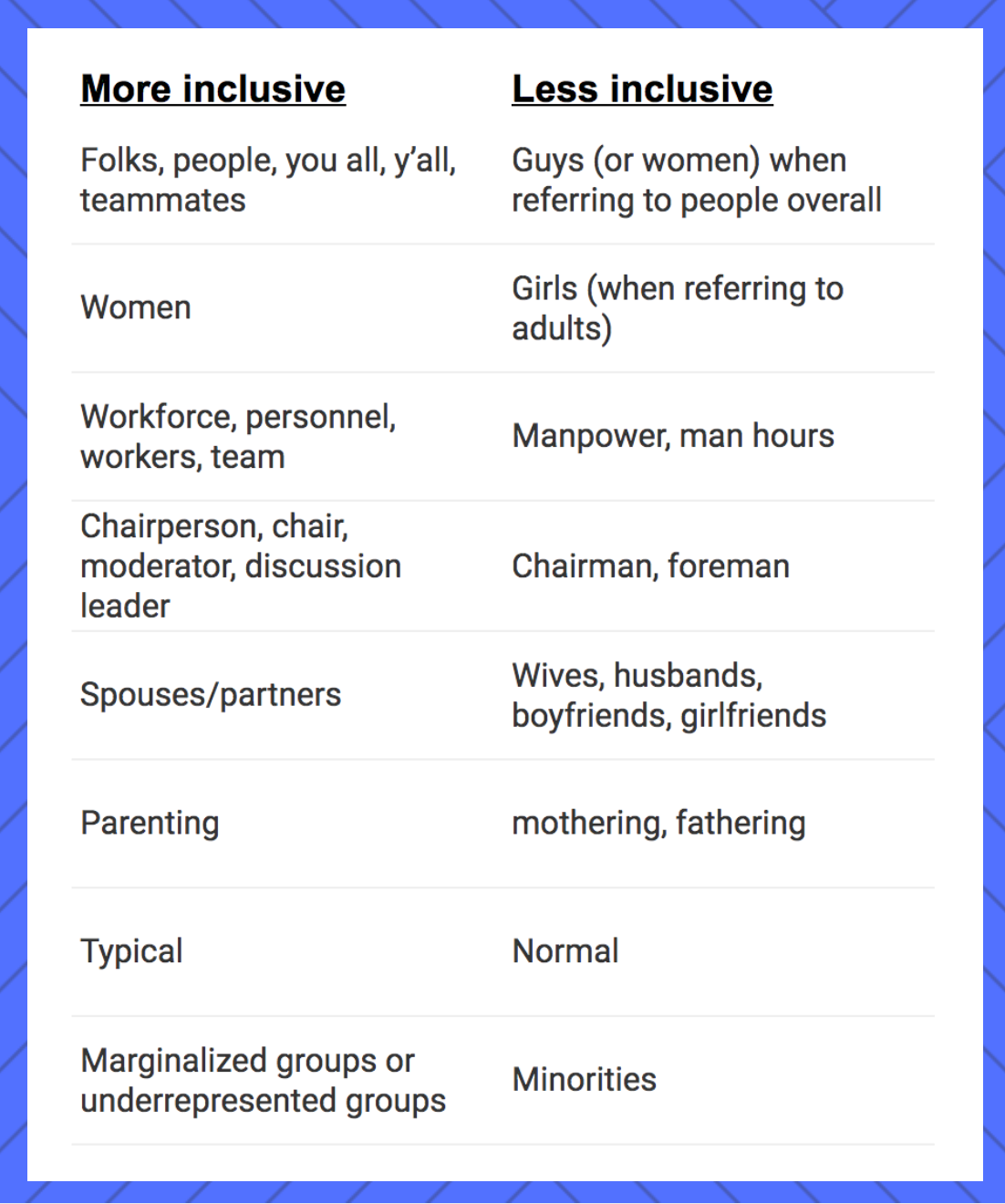
More inclusive: Folks, people, you all, y’all, teammates
Less inclusive: Guys (or women) when referring to people overall
More inclusive: Women
Less inclusive: Girls (when referring to adults)
More inclusive: Workforce, personnel, workers, team
Less inclusive: Manpower, man hours
More inclusive: Chairperson, chair, moderator, discussion leader
Less inclusive: Chairman, foreman
More inclusive: Spouses/partners
Less inclusive: Wives, husbands, boyfriends, girlfriends
More inclusive: Parenting
Less inclusive: mothering, fathering
More inclusive: Typical
Less inclusive: Normal
(There’s bias inherent in using one group as a standard against which others are judged. Use of the word normal as a comparison group can stigmatize people who are different and imply they are abnormal.)
More inclusive: Marginalized groups or underrepresented groups
Less inclusive: Minorities
(Not all marginalized groups are minorities, and a broader term is generally inclusive of more than race and gender)
If this kind of thing interests you, we’d love to invite you to check out (and copy, edit, share) the full blog post with the inclusive language guide in its entirety.
Resource: How to Hire (playbook)
How We Hire: A Look Inside Our Hiring Process
Our hiring workflow may look quite similar to most any other company’s. This is the blueprint we follow (look familiar?):
- Think and write
- Share the role internally, then externally
- Track applicants
- Promote the listing
- Review applicants
- Interview applicants
- Sync with all involved
- Decision time!
Though the general outline is similar, we’ve put a lot of effort into the details — especially the details that make an impact on diversity and inclusion … which is most all of the details!
Specifically, these are some of the ways that we’ve aimed to have a more diverse hiring process:
- Textio is a tool that we now use automatically before posting a listing. Our Textio score predicts how effective the job listing will be at recruiting qualified applicants quickly. It also gives great advice on how to make our listings more gender neutral, inclusive, clear and attractive to qualified candidates
- Share the listing with Underrepresented groups focus: (P.S. We’d love to grow this list if you know of other resources!)
- Our interview questions are the same for each candidate, asked in the same order each time, and we already have in mind (and on paper) what elements we’re looking for in the answer. This may sound boring and robotic, but we’ve learned that it’s the best approach to remove as much bias as possible, and we share this with candidates up front.
You can get the full details and the complete hiring playbook here.
Resource: Code of Conduct
Our Code of Conduct And Why It’s Important For Diversity And Inclusion
While our values do influence our behaviors, we also felt compelled to create a code of conduct to serve as an official commitment to teammates and new or potential hires about the behaviors we expect (and the behaviors we discourage) at Buffer.
Codes of conduct are also common for conferences or other public events to ensure that everyone is respected and comfortable.
You’re welcome to take and use any or all of our code of conduct at Buffer.
Our code of conduct covers the following areas:
- Expected behaviors
- Unacceptable behaviors
- Reporting a problem
Here’s a snippet:
We put forth this code of conduct not because we anticipate bad behavior, but because we believe in the already exceptional level of respect among the team. We believe that articulating our values and accountabilities to one another reinforces that respect and provides us with clear avenues to correct our culture should it ever stray. We commit to enforce and evolve this code as our team grows.
Like our Buffer values, the contents of this code of conduct are concepts we expect teammates to work to apply to their daily lives in and outside of Buffer. Specifically, the code of conduct applies to teammate interactions in various areas of our shared professional lives, including all events hosted by Buffer, shared online spaces (Slack, Discourse, Trello, email, etc.), social media, pull request feedback, and conferences or other events where we represent Buffer.
You can see the full code of conduct here and copy/paste to your heart’s content.
Learn more
From our experience at Buffer:
- The benefits of embracing diversity at your company
- 7 simple ways to be more inclusive
- Why diversity in tech matters
- Inclusive language guide
From these great places and people:
- A diversity and inclusion guide for HR teams – Ideal
- Up-to-date data on diversity in tech – Information is Beautiful
- A ready-made inclusion survey to share with your team – CultureAmp
Over to you
What has your experience been with diversity and inclusion?
What questions do you have or resources do you need?
We’d love to help you make diversity and inclusion a significant part of your workplace. We’ve felt grateful to have been able to take part in this important movement, and we hope we’re making a positive difference. We’d love to have you join us!
Try Buffer for free
180,000+ creators, small businesses, and marketers use Buffer to grow their audiences every month.
Related Articles
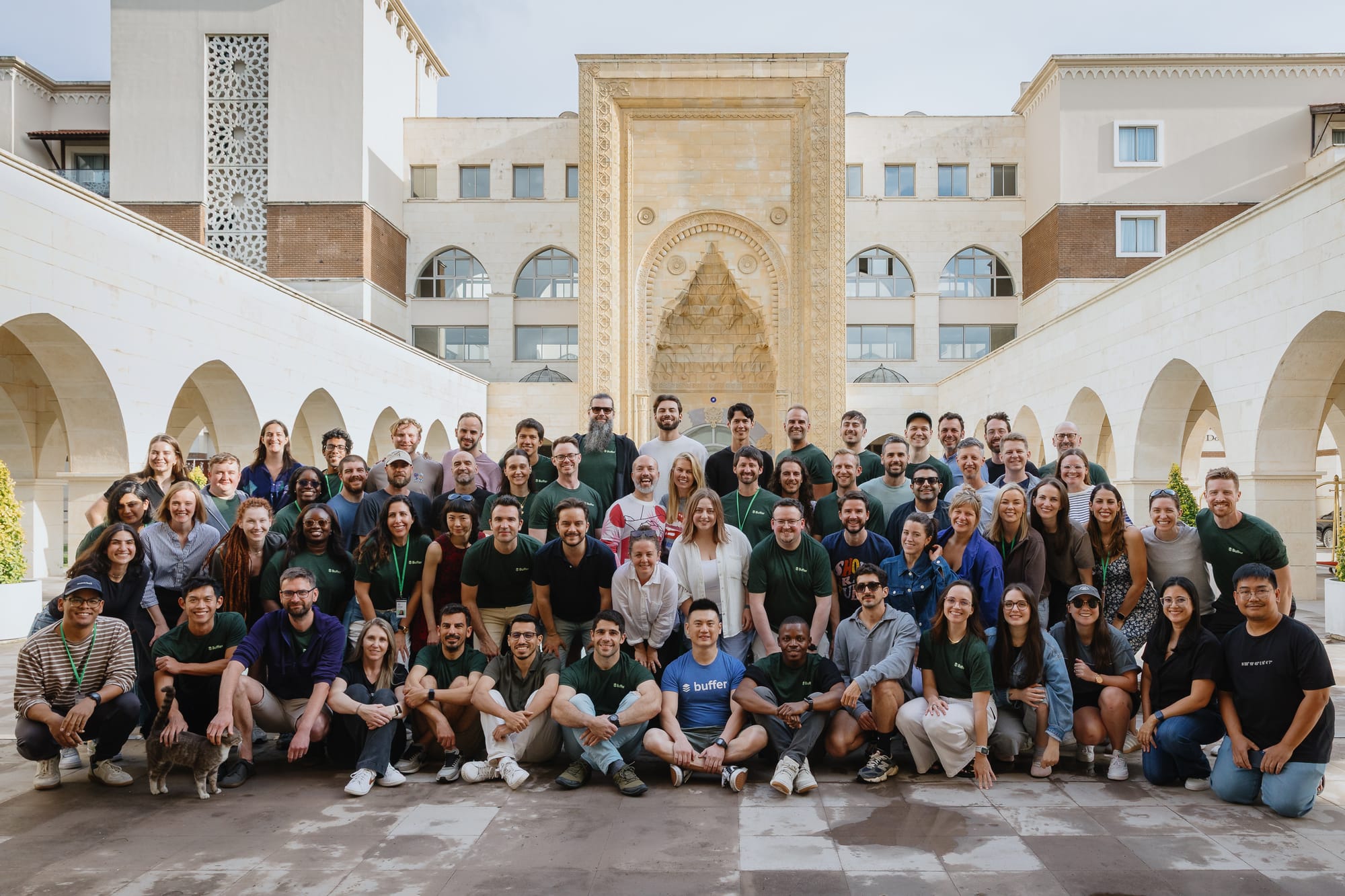
We've been hosting Retreats at Buffer for 12+ years. In this article, we've detailed everything we've learned from 14 Retreats.

I recently attended my first in-person, international conference. Here's what I learned.

What it was like to join a fully remote team like Buffer, and how going on the company retreat so early on helped shape my journey in ways I hadn’t imagined.

